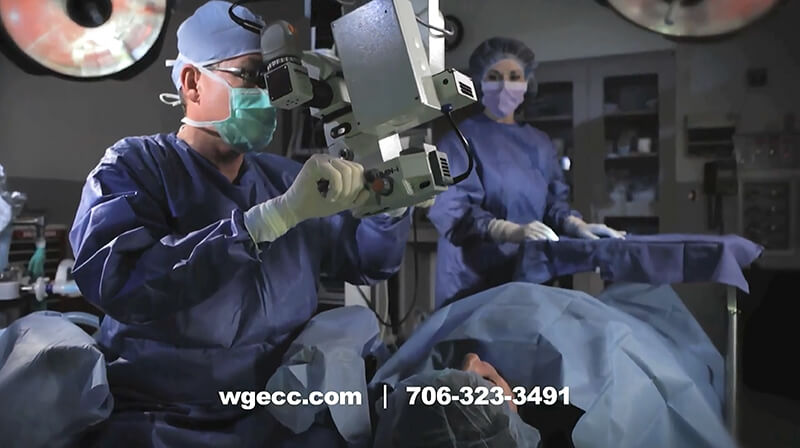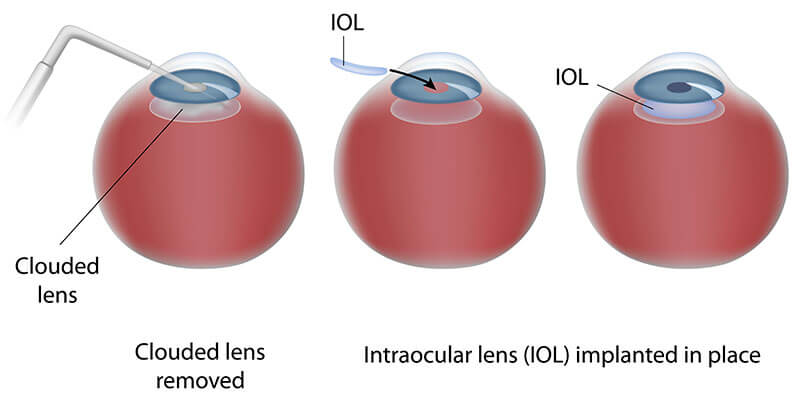Cataract Surgery and Premium IOLs
What Is a Cataract?
A cataract is a loss of transparency, or clouding, of the normally clear lens of the eye. As you age, chemical changes occur in the lens that make it less clear. The loss of transparency may be so mild that vision is hardly affected. On the other hand, it may be so severe that it dramatically impairs eyesight. When the lens gets cloudy enough to obstruct vision to a significant degree, it is called a cataract. Glasses or contact lenses cannot sharpen your vision if a cataract is present.
I Have a Cataract: What Now?
Cataracts must be surgically removed. After diagnosis, your doctor will refer you to a surgeon in order to restore your vision. If you’re a patient at West Georgia Eye Care Center, our ophthalmologists are pleased to offer surgical solutions right here in our state-of-the-art ophthalmic surgery center. Start to finish, we will care for you as you walk through diagnosis, surgery, and post-op recovery.
What Causes Cataracts?
Cataract formation is primarily due to aging. Other causes include trauma, medications such as steroids, systemic diseases such as diabetes and prolonged exposure to ultraviolet light. Occasionally, babies are born with a cataract. Wearing sunglasses may reduce your risk for developing a cataract by limiting exposure to ultraviolet light. However, once a cataract has developed, the only cure is surgical removal. It is time to have surgery when your vision interferes with your lifestyle.
Cataract Surgery & Lens Implantation
Although the formation of a cataract can make activities such as reading and driving difficult, good vision can be safely restored with outpatient cataract surgery. Now, with the development of no-stitch, a small-incision procedure, patients are experiencing a faster recovery.
What Is Cataract Surgery?
Cataract surgery is the most common surgery in America. Our physicians remove the cataract through a small incision using an advanced technique known as phacoemulsification. Ultrasound energy is used to break up the cloudy lens material and remove it from the eye. A new plastic lens replaces the clouded one. Usually, this lens will last you the rest of your life. This lens correctly focuses light to the back of the eye. As with any surgical procedure, complications can occur during or after surgery and some are severe enough to limit vision. However, the overwhelming majority of patients are pleased with the improvement of both their vision and quality of life. Out of the one and a half million people who have this procedure every year, 95% have a successful result.
What is an IOL?
An intraocular lens (IOL) is a replacement lens. When your cataract is removed, a new, clear lens is implanted in its place. IOLs are light, flexible, and about the size of an M&M. On either end, there are tiny “arms” that hold the lens in place. Just like a contact or eyeglass lens, your IOL contains a prescription. There is a wide variety of possible options to fit your unique eye and your lifestyle. Your doctor will be happy to discuss the possibilities and answer any questions you have.
Intraocular Lenses
The team at West Georgia Eye Care Center will work with you to determine the best replacement lens for your lifestyle and visual goals.
PanOptix Trifocal Lens
Premiums Lens Implant
The AcrySof® IQ PanOptix Trifocal IOL is the first IOL of its kind to be FDA approved! Unlike other IOLs, the IQ PanOptix Trifocal IOL provides clear vision at three vision distances: close, intermediate, and far away!
Vivity Lens
Premium Lens Implant
The Vivity IOL is the first and only non-diffractive extended depth of focus (EDOF) IOL. Your range of vision is constantly being stretched and shifted, so the light never splits. When you’re looking at things around you, it means that you can see the world around you crisply and sharply.
Monofocal Lens
With traditional cataract surgery, you will receive a standard monofocal lens that will provide good distance vision, but you will still need glasses for close and possibly for intermediate vision.
Astigmatism-Correcting Lens
If you have astigmatism and choose laser cataract surgery with an astigmatism-correcting monofocal lifestyle lens, you will eliminate both cataracts and astigmatism, but you will still need glasses for improved vision.
Eyhance
Not only does it provide better distance vision, but it allows you to see better at night as well. With the Eyhance lens, you may still need reading glasses, but you get the benefits of sharper vision and a lower risk of visual disturbances.
Which Lens Is Right For My Eye? Premium IOLs and Other Elite Options
There are 2 types of lenses our surgeons use to correct your vision. A monofocal (or monovision) lens focuses light at either distance or near. The cost of this lens is usually covered by your insurance company. If you have your IOL set for distance vision, you may need to use reading glasses for near objects. On the other hand, if your IOL is set to correct your near vision, glasses for faraway objects might be necessary. However, many patients find that monofocal IOLs improve their vision at most distances, and their use of glasses for sharper sight is infrequent. A multifocal lens, such as Restor, focuses light for improved distance and near vision. 80% of patients with this premiere lens no longer need their glasses at all. Restoration of youthful vision does come at a slightly increased cost. Your physician will help you decide which lens is right for you.















